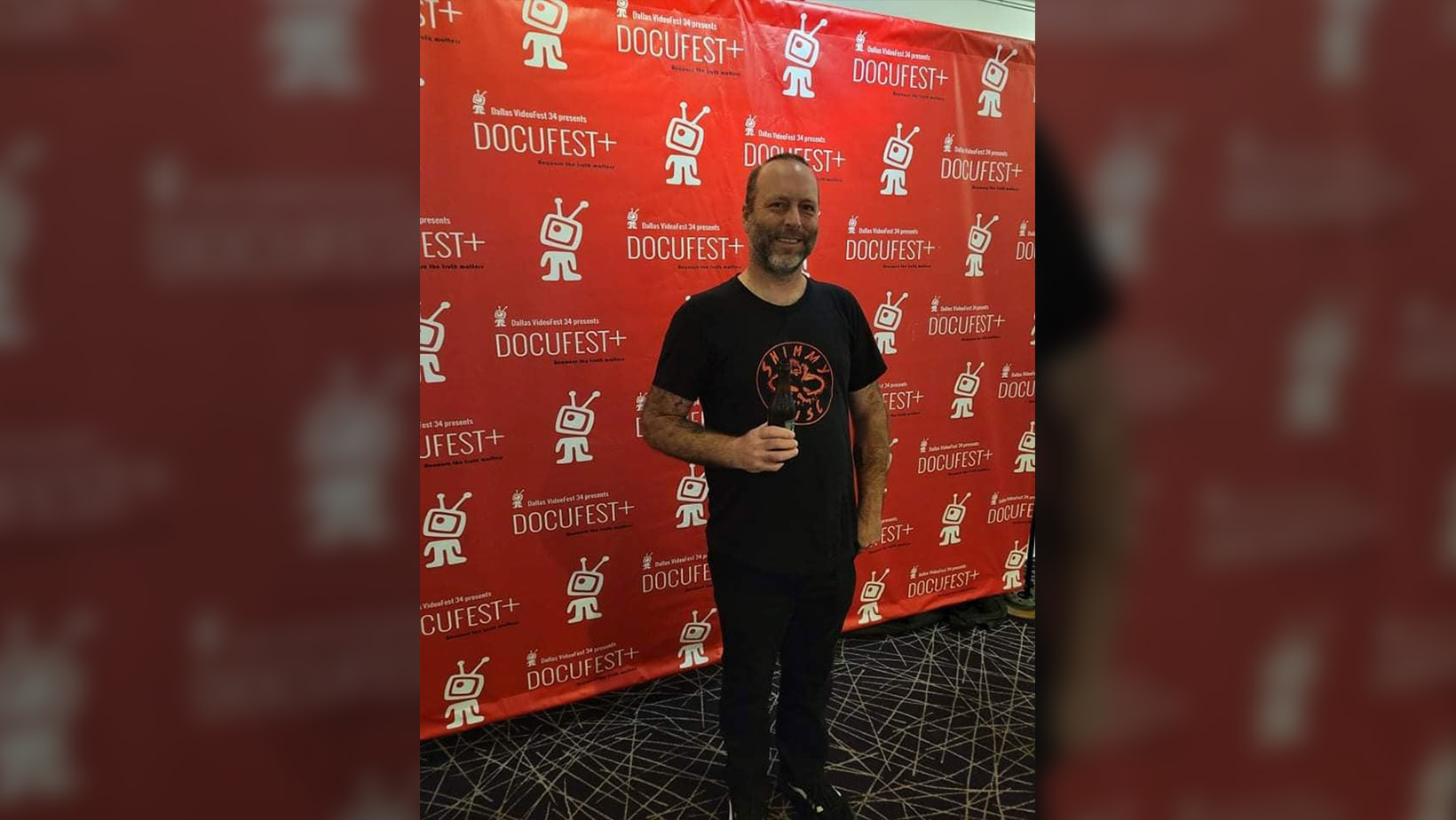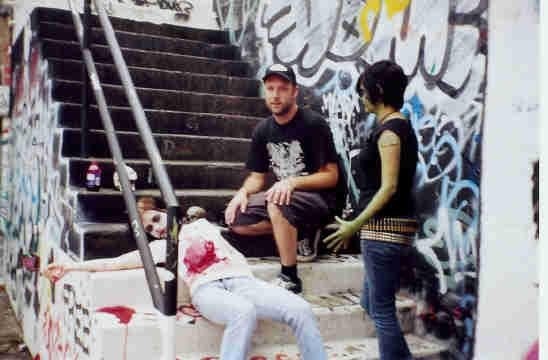

Born in Ft. Smith, Arkansas, USA, Justin Powers is a versatile filmmaker who has worked on multiple aspects of the film creation process. Beginning his career as a grip, Justin went on to work on a multitude of different films over the years such as Alita: Battle Angel (2019), Hairmetal Shotgun Zombie Massacre: The Movie (2016), and multiple TV shows such as The Walking Dead, and Daredevil. However, Justin also has a distinguished career as a writer and director, with titles under his belt such as Pot Zombies (2005), Pot Zombies 2: More Pot, Less Plot (2012), and Everything Is A-OK: A Dallas, TX Punk Documentary (2020). We were lucky enough to get the chance to chat with Justin about his lengthy career in the industry.

Could you tell us about making “It Came from Texas”, Justin? How did the project come about?
I had made a documentary, Everything is A-OK, which is about the history of the Dallas punk scene from the 70’s to the early 2000’s. During the editing process of that project I realized I really enjoyed making documentaries, it’s very time consuming but also very enjoyable if it’s on a subject that you really love. Some things I love a lot are music, movies, and Drive-in theaters, so I was thinking about another music doc or a horror host doc or possibly a drive-in doc. I had the idea for the It Came From Texas documentary a long time ago, even before the punk rock doc, but wasn’t really sure if there would be an audience for it.
At one point I was interviewed by local author/filmmaker/schlockmeister Bret McCormick for his book Texas Schlock, a book about B-movie sci-fi and horror movies from the Lone Star state. I love that book and it really re-ignited my passion for the It Came from Texas documentary idea. I started a deep dive into Texas made B-movies and It Came From Texas was started. It’s been so much fun watching and researching all these crazy films and the filmmakers and people behind them. Bret had interviewed me about my films Pot Zombies and Pot Zombies 2: More Pot, Less Plot for his book and I feel very honored to be featured in a book alongside with the cool directors in that book.
Could you name a few Texas horror directors who are spotlighted in this film?
Yes, the film will feature many films and filmmakers spanning many decades, from the drive-in theater era to the straight to vhs/dvd era. Classic Texas filmmakers from the drive-in era like Larry Buchanan (Mars Needs Women, Zontar the Thing from Venus) and S.F Brownrigg (Don’t Look in the Basement) to straight to video ear filmmakers like Glen Coburn (Bloodsuckers From Outer Space) and Bret McCormick (The Abomination, Repligator). The film will also feature many other filmmakers, films, actors, and fans! We’ll be visiting a couple of locations of some of the films. If you have not seen Bloodsuckers From Outer Space, you need to change that right now.

Could you tell us about the film Manos Hand of Fate? Has this film become a cult classic?
Manos the Hands of Fate is definitely a cult classic….famous for being called the “worst movie ever made”…..I don’t know if that’s true, I have seen some pretty bad movies. I had heard about Manos and seen images from the film for years but I had not watched it until I started working on this project. Manos being featured on Mystery Science Theater 3000 in the 90’s really started its cult following and people have been slowly discovering it ever since. This movie is especially interesting because of the stories behind the making of it. From why it was made, to how it was made, to the tragedy of one of the lead actors who took his own life only a month before the premiere, these are the stories that make Manos so interesting. There is a book out now along with an audiobook from Jackey Neyman Jones, who plays the little girl in the movie. it’s called Growing Up With Manos: How I Was the Child Star of the Worst Movie Ever Made and Live to Tell the Story
Another cult classic being featured in It Came From Texas is Don’t Look in the Basement. It’s a pretty well known movie because it played in drive-in theaters for years and was a famous double feature with Wes Craven’s Last House on the Left. I love the aesthetic of the S.F. Brownrigg films, they all look great with such a cool feel to them. Brownrigg did a lot in Texas low budget film history, working with Larry Buchanan on his films before directing and producing his own. I recently learned of a movie he made way later in ’86 called Thinkin’ Big that is a comedy and way different than his horror films in the 70’s. I really want to check that one out but it’s really hard to find. I was actually the key grip on Don’t Look in the Basement 2, which was an amazing experience. It was directed by S.F. Brownriggs son Tony and was shot in the original house the first one was shot in. We shot on the first couple floors and the cast and crew stayed mostly on the 3rd floor. It was a great experience working and staying at the house with a fun group of people!
Who are some of today’s horror directors From Texas that you think we should look out for?
I’m not sure, there are so many filmmakers all over Texas making their art. This movie is celebrating those passionate people that put in all that work to make their vision a reality, all the filmmakers that are getting it done and making what they want. A lot of the films featured in It Came From Texas are films that not a lot of people saw at first but started finding wider audiences years and decades later.

Do enough horror viewers know about some of the filmmakers mentioned in your documentary?
No, not enough people know about these films and filmmakers. That is the main reason for making this documentary. I hope for this to help these films find new audiences that would not have heard of most of these titles. The average person isn’t going to have heard of most of these, if any of them, but real fans of these kinds of movies will have probably heard of some of them. That’s where I think the fun is in this project, a lot of people will have heard of some of these but even big fans of b-movies will find new titles to seek out! A lot of people have probably heard of Don’t Look in the Basement but how many people have heard of Cornman: American Vegetable hero? Probably not enough!
Why did filmmakers like Tobe Hooper choose Texas as a location for The Texas Chainsaw Massacre?
Tobe Hooper was born and raised in Texas. His family actually owned a movie theater in San Angelo so he grew up studying movies. I think the Texas Chainsaw Massacre is the greatest horror movie ever made. Tobe Hooper put together a great crew and cast that made that movie just amazing. The way that film is shot just really leaves an impact on the viewer and it seems everyone remembers the first time they saw it. While the TCM will probably be mentioned in IT CAME FROM TEXAS somewhere, it will not go in depth about that film or have a segment in the doc. For one, I’m focusing more on cheesier b-movies and Texas Chainsaw Massacre already has several documentaries. There’s already so much information out there about TCM and I really want to bring attention to other lesser known Texas made genre films.
This Interview was provided to Grimoire of Horror by John Wisniewski
More Interviews
Interview with August Hill: A Trip to Division X
Howdy, GoH fam! Dustin here again with a little exclusive moment. If you’ve seen my review of Division X, y’all know that I absolutely loved the book. If you got…
Interview With Ben Scrivens of Fright-Rags (Video Content)
“Fright-Rags is an American company known for releasing apparel based on horror films and other horror-related media. The company was founded in 2003 by Ben Scrivens, and is based in…
Interview with Dick Dale – Director of Ribspreader (2022)
Dick Dale is an Australian writer/director/producer with a strong focus on video nasties and splatter films. Dick is most notable for directing the short dark comedy Creamy Love (2001) and…
Interview with Director/Editor Thomas Burke – Found Footage Aficionado
Thomas Burke is an award-winning filmmaker and editor based out of Austin, Texas. He has spent over the last decade freelancing in various production roles including film directing, acting, producing…



